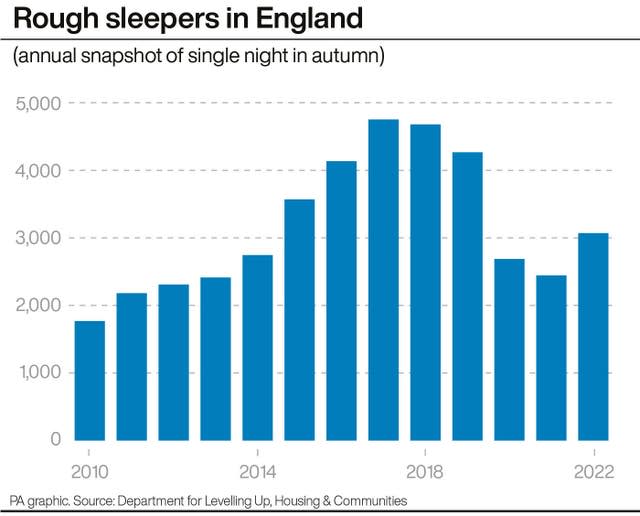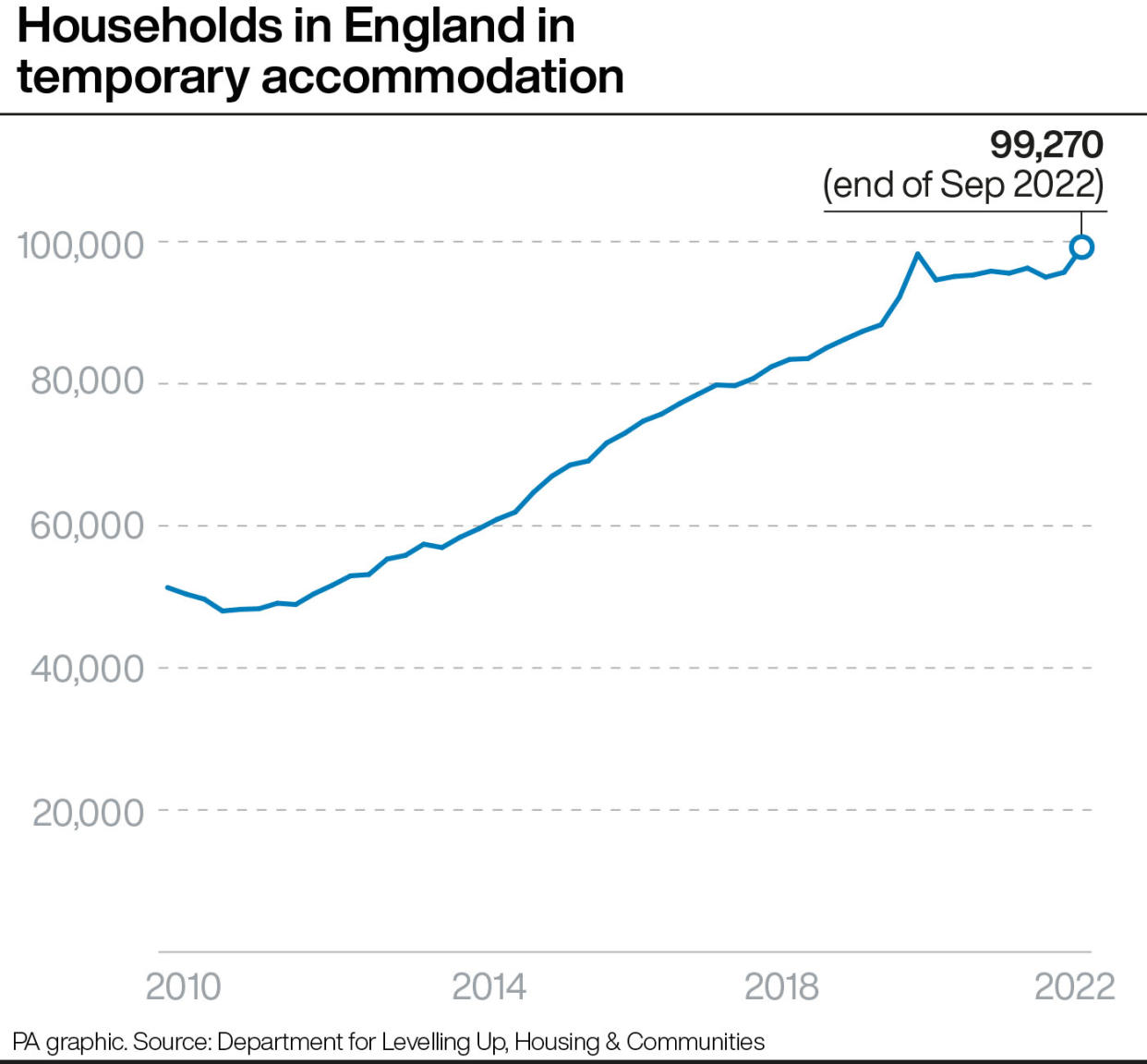Number of people sleeping rough in England rises for first time since 2017
The number of people estimated to be sleeping rough in England has risen for the first time since 2017, new figures show.
A snapshot of a single night in autumn last year found 3,069 people sleeping rough, up 626 (26%) on the equivalent total for 2021 and nearly three-quarters (74%) above the level in 2010 when the figures began.
The increase has been branded a “massive, collective failure” by a charity, and comes after the Government published its Ending Rough Sleeping For Good strategy in September, which restated its manifesto commitment to end rough sleeping by the end of this Parliament.

The Government acknowledged that while rough sleeping “remains well below pre-pandemic levels” there is “more to do to help families at risk of losing their homes and to end rough sleeping for good”.
Rick Henderson, chief executive at Homeless Link, which is the national membership charity for frontline homelessness organisations, said the rise of more than a quarter year-on-year since 2021 “is evidence of how the cost-of-living crisis has exacerbated long-standing drivers of homelessness”.
He said: “Everyone deserves a safe place to live and the support they need to keep it. This shocking rise in the number of people sleeping rough represents a massive, collective failure. People are being let down by systems that should protect them, forced onto the streets at the expense of their physical and mental health.
“The 26% rise is evidence of how the cost-of-living crisis has exacerbated long-standing drivers of homelessness, such as a shortage of affordable housing, an often punitive welfare system and increasingly stretched health services.”
He urged the Government to take “urgent action to keep homelessness services open” by increasing funding in line with inflation.
The rate of people sleeping rough on a single night in England in 2022 was 5.4 people per 100,000 – up from 4.3 per 100,000 in 2021 but lower than the 8.5 per 100,000 in 2017, according to the Department for Levelling Up, Housing and Communities.
Rough sleeping has increased in every region of England year-on-year, with the biggest rise in London (34%).
There were 858 people in 2022 estimated to be sleeping rough in the capital on a single night compared with 640 people in 2021, an increase of 218 people.
Almost half (47%) of all people sleeping rough on a single night in autumn are in London and the South East.
Mayor of London Sadiq Khan described the rise in people sleeping rough on London’s streets as “extremely alarming and further evidence of the devastating fallout from the cost-of-living crisis”.
He said: “It is high time ministers got a grip on the escalating food, energy and housing crises and restored the social security safety net which helps stop people becoming trapped in a cycle of homelessness.”

Over half of the year-on-year increase in rough sleepers is accounted for by 15 local authorities: Bournemouth, Christchurch and Poole; City of London; Cornwall; Croydon; Haringey; Hillingdon; Leicester; Liverpool; Manchester; Newham; Reading; Southampton; Waltham Forest; Westminster and Worthing.
Across these 15 authorities, the number of rough sleepers rose by 326 – 52% of the total increase for the whole of England.
Westminster in London saw the biggest numerical increase, up by 63 from 187 to 250, followed by Bournemouth, Christchurch and Poole (up by 35 from 29 to 64), Leicester (up by 26 from eight to 34) and the City of London (up by 23 from 20 to 43).
Peterborough recorded the biggest year-on-year numerical decrease, down by 12 from 36 to 24, followed by Bristol (down by 10 from 68 to 58), Enfield (down by 10 from 21 to 11) and Bassetlaw (down by nine from 17 to eight).
As with previous years, most people sleeping rough in England are male, aged over 26 years old and from the UK.
Separate government figures published on Tuesday showed that 75,860 households were initially assessed as homeless or threatened with homelessness between July and September last year, up 4% on the same period in 2021.
Households threatened with homelessness due to service of a Section 21 notice – known as a no-fault eviction – numbered 6,170, a rise of 34% from the same quarter the previous year.
The Government has previously stated its intention to bring forward legislation this year to ban Section 21 no-fault evictions, which currently allows landlords to quickly evict tenants without having to give a reason.
As of September 30 last year there were 99,270 households in temporary accommodation – a rise of 4% from the same date the year before.
The most common reason for households needing help to prevent homelessness was that their private rented Assured Shorthold Tenancy (AST) had come to an end.
Of the households owed a prevention duty for this reason, the biggest increase was due to rent arrears caused by rises in rent.
A spokesperson for the Department for Levelling Up, Housing and Communities said: “Over half a million households have been prevented from becoming homeless or supported into settled accommodation since 2018 and rough sleeping remains well below pre-pandemic levels. But we know there is more to do to help families at risk of losing their homes and to end rough sleeping for good.
“That’s why we will be abolishing Section 21 evictions and are investing £2 billion over three years to tackle the issue allocated to areas with the greatest need.
“This includes financial support for people to find a new home, working with landlords to prevent evictions or providing temporary accommodation, among other preventative measures. Councils have a duty to ensure families are not left without a roof over their head.”
Matt Downie, chief executive of the charity Crisis, said the rise in homelessness “frankly shames our society and if alarms bells weren’t ringing across government, they should be now”.
He said the rise in no-fault eviction notices being served shows “we’re on an extremely dangerous course” and said people are being left “exposed, lacking what should be a basic legal protection” as they await changes under the Government’s much-delayed Renters’ Reform Bill.
Polly Neate, chief executive of Shelter, said the latest figures show that “more and more people are losing the battle to keep a roof over their heads”.
She said: “We’re facing a truly bleak situation, from the huge rise in people being forced to sleep rough on the streets, to the tens of thousands of households turning up at local councils desperate for help.
“To stop homelessness snowballing further the Government must use the Spring Budget to unfreeze housing benefit, which is still stuck at 2020 levels.
“But the only way to end homelessness for good is to build social homes with rents pegged to local incomes.”
